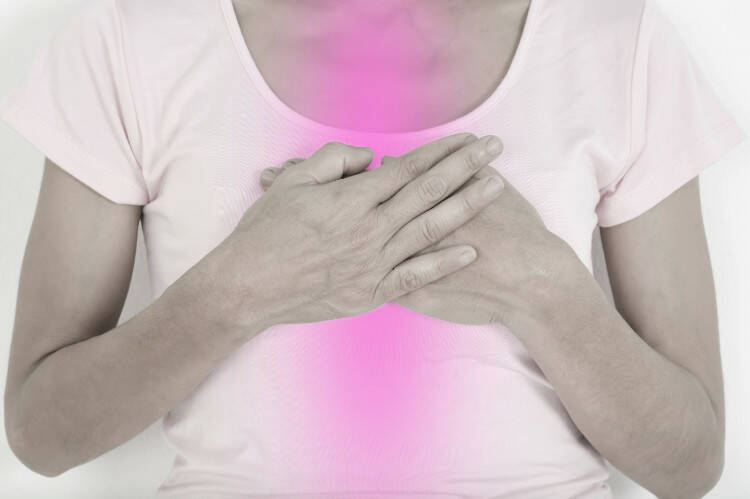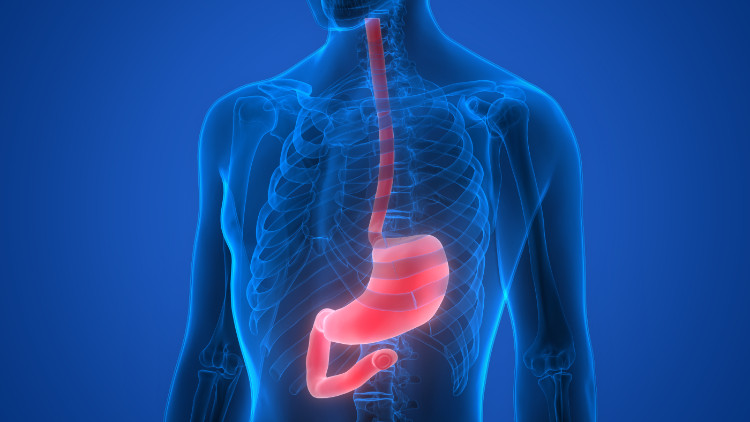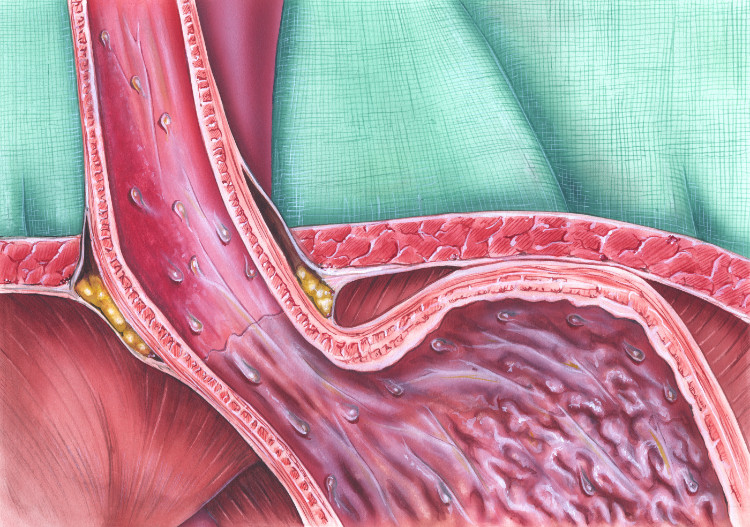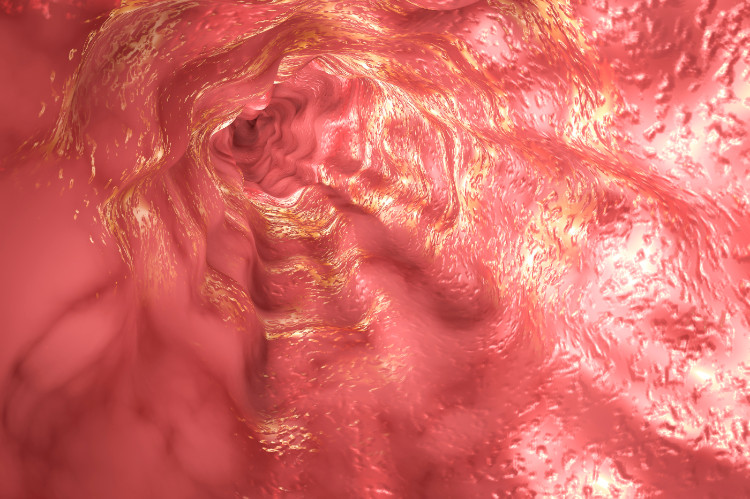Treatment and diet for heartburn: what to eat and which foods are inappropriate?

Are you one of those who sometimes suffer from an unpleasant burning sensation in the esophagus, or have you even been struggling with this problem on a daily basis for many years? If you answered yes, then we have some valuable advice for you on how to quickly and effectively get rid of this unpleasant problem or at least relieve the burning in your throat. Heartburn or gastroesophageal reflux is a condition that can be relieved in most cases by medication, but also by eating right - diet.
Article content
Heartburn is uncomfortable and bothersome. It limits us in our daily lives and prevents us from eating everything we want to. Some causes of heartburn are temporary or solvable. Others place dietary restrictions on us.
What to eat and what not to eat for heartburn?
What best neutralizes an acid stomach?
Why does heartburn occur?
An unpleasant burning sensation in the oesophagus and throat is felt when food and stomach acids are returned upwards from the stomach (gaster). Stomach acids, especially hydrochloric acid (HCl), are irritating to the oesophageal mucosa. Gastric juices have an acidic pH. Apart from HCl, they contain mainly water, pepsin, gastrin, chymosin and lipase. Their action is felt as burning and, if persistent, can damage the oesophageal mucosa.
A specific complication of damage to the oesophageal mucosa is the so-called Barrett's oesophagus. This is a mucosal injury in which the originally squamous epithelium is replaced by a gastric-like epithelium - a metaplastic, cylindrical epithelium. In worse cases, bleeding can occur. Patients with Barrett's oesophagus have an increased risk of developing cancer in the area of the damaged mucosa.
The reason for reflux and burning is the disruption of the antireflux barrier due to various causes. This is formed by the oesophageal sphincter in its lower part at the border with the stomach (pars abdominalis).
What burns us?

Heartburn (pyrosis) is actually a burning sensation in the oesophagus due to the return of gastric juices and acids that trigger it. The oesophagus is the first part of the alimentary canal itself. It is a tubular muscular organ about 25 cm long, starting behind the oral cavity and pharynx and ending in front of the stomach.
The esophageal wall consists of four layers (tunica mucosa, tela submucosa, tunica muscularis, tunica adventitia). It consists of smooth muscle, flat and cylindrical epithelium along with collagenous and elastic fibers, sparse connective tissue, mucinous glands.
Gastroesophageal reflux disease (GERD) - symptoms
Gastroesophageal reflux translates as gastro-oesophageal reflux. It is the actual process of the stomach contents returning back to the oesophagus, which is also known professionally as regurgitation. The main symptom is pyrosis (heartburn), which mimics chest pain of various aetiologies (causes). This causes nausea (lack of appetite) to vomitus (vomiting).
Extra-gastric symptoms include hoarseness, irritant coughing when stomach contents are aspirated, with complications such as pneumonia. Laryngitis from chemical irritation of the larynx is also common. If the contents reach the oral cavity, their chemical composition and pH cause a bitter taste in the mouth, an unpleasant odour, weakening of tooth enamel and increased tooth decay.
GERD is accompanied by heartburn and can be a symptom of stomach acidification due to poor diet and the pH of the refluxate (returned contents) itself, and sphincter level disorders. It is triggered by certain types of drugs and foods, but also occurs as a result of other diseases. However, there are many more contributing factors than, for example, pregnancy or obesity.
The main causes of heartburn
The causes of heartburn are varied. Most often, it is a combination of increased acidity in the stomach with another disease such as pylorosthenia. A sphincter disorder causes the juices to return and the increased acidity multiplies the burning sensation. However, it is far from the only cause and their combination.
Stomach disease
Heartburn may be caused not only by diseases of the oesophagus, but also of neighbouring organs such as the stomach. In the stomach, hydrochloric acid itself is formed with other components that cause the burning sensation when they reach the higher parts of the digestive tract.

1. Gastritis and gastric ulcer are two diseases that are related to each other. Under the influence of various pathogens, the gastric mucosa changes and undergoes an inflammatory process. It is red, loose, excessively blooded and swollen. This is manifested by pain in the stomach area, increased acidity with the possibility of gastric ulcer. Both diseases can manifest themselves with heartburn.
2. Gastric cancer is a malignant, cancerous disease of the stomach. Genetics, obesity, diet, smoking or alcohol play a significant role in the cause. It is manifested by pain, lack of appetite, repeated vomiting. Vomiting causes irritation of the esophagus, its burning and subsequent changes in the mucosa.
Pylorostenosis often affects newborns and children at an early age. It is characterised by hypertrophy and hyperplasia (bruising of the tissue) of the pylorus - the pylorus (the upper part of the stomach). The dominant symptom is massive vomiting sometimes with blood, dehydration, weakness, malaise, pain and burning of the oesophagus, persistent hunger or infrequent stools.
Diseases of the esophagus

1. Oesophageal cancer is a very serious malignant disease which is asymptomatic for a long time. The first symptoms appear only when the tumour affects more than two thirds of the oesophagus. It causes chest pain, swallowing disorders due to narrowing of the oesophagus and regurgitation of the contents. The chemical composition of an unsuitable diet is the cause of burning. It occurs mainly in smokers, chronic alcoholics and people with inappropriate eating habits (fatty, spicy or excessively salty foods).
2. Infectious oesophagitis is an inflammatory disease of the oesophagus, the causative agents of which are usually viruses (cytomealovirus, herpes virus) and mycotic infections (candida). People with immune deficiency or after frequent treatment with antibiotics are at risk.
3. Corrosive oesophagitis is an inflammatory reaction of the oesophagus when it is poisoned by acids and alkalis. It is a chemical damage to the oesophagus. Usually such a condition occurs in accidental poisoning. It is manifested by severe pain, mucosal damage, poisoning, inflammation, burning, nausea and vomiting. The danger lies in the possibility of perforation of the oesophagus and the passage of infection into the chest cavity.
4. Esophageal varices are enlargement of the vascular plexus in the esophagus. The provoking cause is often alcohol and portal hypertension (increased pressure in the hepatic circulation). In alcoholic damage, they are often combined with gastritis, gastric ulcer, liver cirrhosis or alcoholic hepatopathy, an erosive process of the esophageal and gastric mucosa. They manifest themselves with pain, swallowing disorders, inappetence, regurgitation, burning and, in the late stage, their rupture with the possibility of bleeding.
Foods to avoid
1. Sweet foods - cakes, sweets, chocolates, sweetened drinks such as cola...
2. Fatty and fried foods - fast food, chips, burgers, pizza, fried pork, but also other meats, neck meat, crackling, bacon, lard...
3. Excessively salty foods - salted peanuts, excessive salting of any food in general
4. Spicy foods - different types of spices, spicy sauces, chilli
5. Dairy products - milk, especially full-fat, and cream (and possibly products made from it) aggravate reflux. Some people mistakenly believe that milk helps, and even use it to this day for heartburn. You may feel momentary relief by neutralizing it, but ultimately it contributes to acidosis.
6. Alcohol has an adverse toxic effect on the esophagus, stomach and liver.
7. Cigarettes contain nicotine and cancer-causing substances. They damage the whole organism, primarily the organs with which cigarette smoke comes into direct contact (lips, skin, oral mucosa, throat, oesophagus, stomach, larynx and respiratory tract).
8. Irregular/excessive eating - overeating puts a strain on the digestive tract with accumulation of toxins, acidosis (acidification of the body) and subsequent complications. One of these is gastritis with progressive ulcer formation and reflux.
Drugs that trigger GERD
1. Aminophilinum is a preparation, or rather the active substance of preparations used mainly in the treatment of respiratory disorders. Their main indication are diseases of the respiratory system, such as asthma or bronchitis. They have a bronchodilator effect - they dilate the bronchi. The preparation is contraindicated in digestive diseases, for example, in liver failure or bleeding in the digestive tract. Side effects are inappetence, vomiting, heartburn and others.
2. Calcium channel blockers are used to lower blood pressure and treat angina pectoris or, in layman's terms, chest pain. They increase the blood supply to the heart muscle, thus improving blood flow and oxygen supply. Like all drugs, calcium channel blockers have side effects. Although not very common, they cause liver problems, pancreatitis or gastritis with subsequent gastroesophageal reflux. These problems are rarely observed, mostly with long-term use of the drug.
3. Nitrates, also known as isosorbiddinitrate, isoket, monotap, olicard, are most commonly used in the treatment of angina pectoris. They increase blood flow to the heart muscle, thereby relieving chest pain. Secondarily, they lower blood pressure. Thus, the negative effects include mainly hypotension (low blood pressure) with reflex tachycardia (rapid heartbeat). They also cause nausea, vomiting, heartburn and others.
Other causes

1. Pregnancy is one of the main causes of heartburn in women. It occurs at the beginning because of hormonal changes, it can accompany the entire course. Towards the end of pregnancy, its occurrence is due to the pressure of the fetus on the stomach and the return of gastric contents to the esophagus. Anyway, it occurs very often, almost in every pregnant woman. It is even among the first indicators of pregnancy.
In the first weeks, the reasons for heartburn are hormonal, specifically due to the hormone progesterone, which belongs to the gestagens. Another reason is also the change in the motility of the gastric mucosa and the more frequent return of gastric juices and acids to the esophagus.
At the end of pregnancy, the fetus is already large enough to press on neighbouring organs. It also presses on the intestines, causing frequent constipation, but also on the stomach. Women suffer from inappetence, nausea, heartburn and even vomiting.
2. Obesity is the cause of many diseases, sometimes resulting in death. It also causes indigestion, not least heartburn. The bulkiness mainly in the abdominal part (stomach) puts excessive pressure on the stomach and loads the oesophageal sphincter, causing it to open excessively and leak acids into the oesophagus.
However, obesity as such is usually caused by improper eating habits which multiply reflux, especially if continued. Inappropriate foods are described above under foods causing reflux.
3. Ascites is the accumulation of free fluid in the abdominal cavity. It occurs mainly as a pathological process of primary liver disease. It is most often seen in alcoholics as the so-called "spider belly". The increase in abdominal volume, as in pregnancy, results in oppression, which causes digestive discomfort in the sense of constipation, dyspepsia, nausea, heartburn, vomiting.
However, the increased pressure may not only affect the organs of the digestive tract, but also, for example, the lungs. The affected person has difficulty, for example, breathing, is more likely to be short of breath and has lower performance. The pressure may also affect the musculoskeletal system and general mobility.
4. Stress results in a number of problems, mainly insomnia, concentration problems, digestive problems such as nausea, vomiting, heartburn, constipation, diarrhoea or excessive bloating and flatulence.
Stress also causes increased use of various substances such as alcohol, cigarettes, as well as increased intake of various foods. Such eating along with stressful factors is the ideal combination involved in the development of reflux.
How to prevent reflux?
As with all diseases and symptoms, the most important thing is to prevent their occurrence. It is easier and less demanding than the subsequent treatment and suppression of symptoms. In gastroesophageal reflux, it is also necessary to treat the underlying disease and, in parallel with the treatment, to control the resulting symptoms. For this, we can use medicines, but also some foods with a very positive effect on the digestive tract as such.
Drug therapy
In the treatment of GERD, antacids (from the Latin anti - against, acidum - acid) are used. They reduce the acidity in the stomach by neutralising hydrochloric acid and reducing peptic activity. This protects the mucous membranes of the stomach, duodenum and oesophagus. They prevent inflammation, ulcers and unpleasant heartburn.
Suitable foods
Foods suitable for heartburn are primarily foods with an alkaline pH - alkalizing. Since acid is formed in the stomach and enters the esophagus later by the ascending route in esophageal sphincter disorders, it is necessary to act primarily in the stomach. For this reason, they are identical to the foods recommended for gastric ulcer.
Proper drinking regime - water brings important nutrients into the body and in turn the products of cell metabolism are flushed out of the body. It helps maintain the alkaline environment of the body by diluting the excess acidity of the cells, keeping them in a healthy alkaline state. Hexagonal water with a pH of 8.5 - alkaline or even so-called "living water" - is the most suitable to maintain the acid-base balance of the body. It is obtained by electrolysis of drinking filtered water. Spun tap water does not have these abilities. It is also reduced by added substances such as chlorine (tap water should be allowed to stand or boiled before drinking). Some types of tea are also suitable.
- Spirulina is a green-blue algae with an alkaline pH. It cleanses the stomach lining, thus contributing to the proper function of the stomach, and detoxifies the body. This reduces and suppresses excessive stomach acid production and reduces the risk of reflux. It contains many minerals such as iron, silicon, calcium, phytonutrients, enzymes, vitamins, chlorophyll and amino acids. The algae chlorella pyrenoidosa, which produces digestive enzymes, has similar effects, but has greater effects on the lining of the intestine and its proper function. It is more suitable for problems with stools - constipation.
- Vegetables that help in the treatment of ulcers and subsequent gastroesophageal reflux include broccoli, which contains vitamins B, C, E and provitamin A. It is a source of iron and folic acid, as well as beta-carotene, calcium, sulphur, zinc and phosphorus. It kills Helycobacter pylori, which causes stomach ulcers and heartburn.
- Capsicum has high amounts of vitamins A, B, C, E, K, iron, folic acid, carotenoids, magnesium, calcium and fiber. It also contains potassium which helps in water management.
- Spinach is a source of vitamins A, B6, E, K, iron, calcium, magnesium, folic acid, L-ascorbic acid, cobalamin, flavonoids with antioxidant effects. It is an excellent helper in the fight against heartburn, gastritis or ulcers.
- Cabbage contains vitamins B, B12, C, E and K, selenium, potassium, iron, zinc, calcium, beta-carotene, fibre. The high amount of fibre has a beneficial effect on digestion, prevents stomach ulcers and fresh cabbage juice is used for heartburn.
- Celery, as a source of B-complex, contains all the B vitamins. It also contains vitamins A, C, E and K. Among the minerals are iron, zinc, potassium, magnesium, chromium, sodium, calcium and iodine.
- Carrots are a carrier of vitamins A, B, C, D, E, iron, calcium and potassium. It helps in metabolism, detoxification of the body and aids proper digestion, thus preventing overacidity, inflammation, ulcers and reflux.
- Potatoes have in them vitamins B1, B2, B3, B5, B6, B9, C, K, PP, iron, potassium, zinc, sodium, manganese, phosphorus and calcium. Potatoes positively affect digestion because of the high content of vitamin C and carbohydrates. It is to carbohydrates that we owe the feeling of fullness. Potato juice is used for inflammation of the stomach, also as a prevention of ulcer disease and heartburn.
- Avocado contains vitamins A, B, C, E, K, a huge amount of potassium, iron, folic acid, zinc, manganese, copper, phosphorus, thiamine, riboflavin or niacin. For its positive anti-inflammatory effects, it is suitable in the fight already formed gastritis, ulcers. By treating inflammatory processes on the stomach, it relieves acidity and soothes the burning sensation in the esophagus.
- Grapes have a beneficial effect on anti-inflammatory and anti-acidity properties. One grape berry contains 80% water, carbohydrates, vitamins B6, C and E, and among the minerals are iron, magnesium, calcium, sodium, copper, manganese, phosphorus. It restores cell structure, aids digestion, contributes to fat metabolism and has a detoxifying effect.
- Apricots are a source of beta-carotene, potassium, phosphorus, magnesium, calcium, vitamins A, B1, B2, B6, C and K. They regenerate cells, have a beneficial effect on the mucous membranes (also stomach and esophagus), especially in smokers. Overall, they help the digestive system.
- Apples contain vitamins A, B, C, E, K, folic acid, pantothenic acid, potassium, phosphorus, magnesium and sodium. They disinfect the oral cavity, esophagus, rid the body of toxins due to malic acids, help to cure liver and gallbladder diseases. They regulate the acidity of the stomach - prevent its increased acidity, thereby preventing reflux disease. They are important in the prevention and treatment of increased stomach acidity, gastritis, the development of reflux and gastric ulcers.
- Peaches are a source of vitamins A, C, antioxidants, potassium, magnesium, selenium, zinc and fibre. They have a detoxifying effect on the body (they rid us of harmful toxins) and a laxative effect. They cleanse the digestive tract, help in the prevention of gastritis, oesophagitis, reflux, ulcer disease and promote weight loss.
- The banana is one of the most suitable foods because it is the least irritating to both the stomach and oesophageal mucosa. It is a reservoir of vitamins A, B, C, E, K, niacin, folic acid and pantothenic acid. It aids digestion and is especially recommended for gastritis, gastric and oesophageal ulcers. It should not be omitted from the diet of smokers because it relieves withdrawal symptoms. Similarly, it should not be avoided by people addicted to alcohol, who are at increased risk of the diseases described above.
- Blueberries contain vitamins A, B, C, E, K, iron, calcium, sodium, zinc, selenium, manganese, magnesium, potassium, phosphorus and folic and pantothenic acid. They are anti-inflammatory and detoxifying. They aid digestion. They are the only ones that relieve vomiting and thus prevent an increased risk of heartburn.
- Dandelion aids digestion by detoxifying the gastric mucosa, contributing to its proper function, removing dangerous metabolic products. This prevents excessive acidification of the stomach and subsequent heartburn.
In gastritis, ulcer disease and GERD, wholemeal bread should be preferred to white bread, lean meat to fatty meat, and preparation is also important. Vegetables and fruit are best eaten raw. This is not the case with broccoli, which has an increased sulphur content, which evaporates with boiling. The aforementioned banana or cottage cheese has a soothing effect on the stomach and oesophagus.










